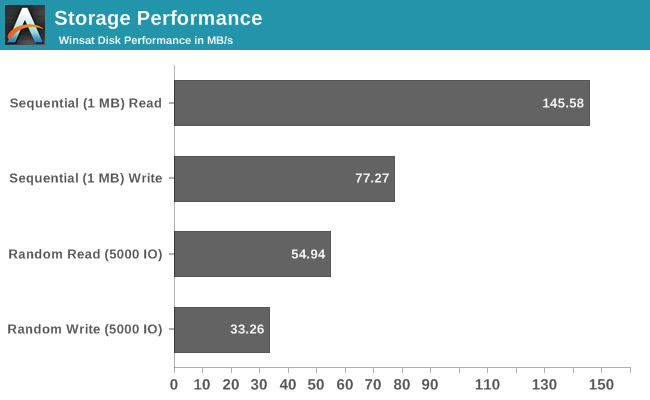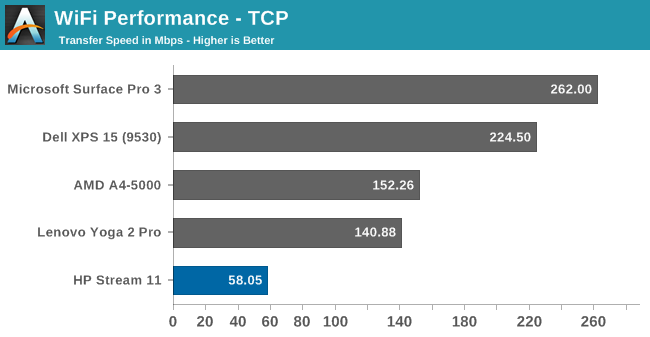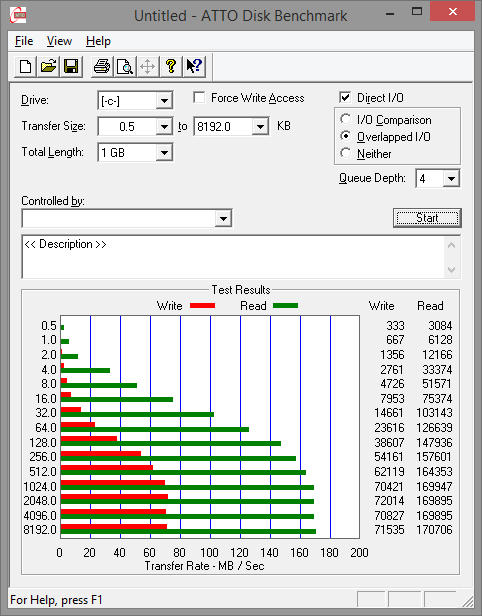HP Stream 11 Review: A New Take On Low Cost Computing
by Brett Howse on December 17, 2014 8:00 AM ESTStorage Performance
The HP Stream 11 has 32GB of eMMC based flash storage, which shows as Hynix HBG4e. It is also the first device I have seen which leverages WIMBoot, which arrived at Microsoft's Build conference as part of Windows 8.1 Update to lower the storage requirements for Windows PCs. Traditionally, PCs come with Windows installed on the C: drive, and include a recovery partition to allow people to reset or refresh their computers back to factory specifications. WIMBoot saves quite a bit of space by not actually installing all of the Windows files, but rather keeps them compressed in the WIM image on the recovery partition. This allows the actual Windows Install to only be around 4GB.
However it is not all good news. Performance will be lower, because the files will need to be uncompressed when accessed. Also, the recovery partition cannot be removed like on a normal install, so while you do save space on the actual C: drive, if the recovery partition is on the same disk, then it may take up quite a bit of room, especially if the OEM has installed a lot of software into the WIM, which they are known to do from time to time. In the case of the HP Stream 11, the amount of storage taken up by Windows and the recovery partition is about 11GB, with the recovery partition itself at 7.2GB. Out of the box, of the 32GB of eMMC available, only 17.5GB is free, and it is quickly filled to the point where you need to manage the storage. Multiple user profiles can quickly fill several GB each.
My biggest complaint about the HP Stream is the lack of storage. Doing the review, it was something that I bumped into constantly as many of the benchmarks are quite large. It does include a SD Card slot, so an extra 32GB or so there is almost a necessity, but of course having your files stored on a removable drive comes with its own risks and complications. Be sure to back them up no matter where they are.
Normally to evaluate Storage performance on laptops, we turn to Futuremark’s PCMark 8 test suite. However this requires 30GB of storage free to run the storage tests, so we can’t compare the eMMC in this device to other notebooks with SSDs using that graph.
I turned to a couple of other benchmarks to get a feel for the storage performance. Windows has some build in sequential and random read/write storage benchmarks, which resulted in these numbers:

I also used the ATTO Disk Benchmark to get a result across 1GB of storage. eMMC is not as fast as SSD, especially with small file performance. With a transfer size of 512 bytes, it would only achieve 0.32 MB/s write and 3.0 MB/s read performance, but as the transfer size increased the performance was quite good, with a maximum write of 70.3 MB/s and a maximum read of 166.7 MB/s.
Boot times are also very good, with a time from off to lock screen of around 10 seconds. The HP Stream 11’s 64-bit version of Windows also supports Connected Standby, so wake from sleep is pretty much instant. The storage performance is certainly acceptable, and I would personally take NAND over a spinning disk every time.
Wi-Fi Performance
Wireless networking is one of the first things to be cut when looking at building a budget device. Consumers may not realize that 802.11n support does not always mean the same thing, but the tick box is still checked on the specification sheet. The HP Stream 11 has taken the wireless performance to the ultimate low, implementing a Realtek RTL8923BE wireless card with Bluetooth 4.0 support. The adapter is 802.11n compatible, but with some big caveats.
Unsurprisingly, there is no 5 GHz support, but even the 2.4 GHz range only has a single stream, and only 20 MHz channel support. This gives a maximum connection speed of only 72 Mbps. Generally this is fine for web browsing, but any sort of large file transfers will be extremely painful. For testing, I keep several large files on my server that I normally just copy over the network, but with this device I found myself using a flash drive and copying them over that way.
As reviewers and consumers, we always expect the best, but with a budget this tight HP obviously found it easiest to save a few dollars on the network card. It is pretty disappointing to see this kind of performance in 2014.

Our standard Wi-Fi test only produced a result of 58.05 Mbps, which is a pretty awful result. I can excuse the lack of 5 GHz on this card, but to opt for a single channel only and on that stream to only support 20 MHz channels rather than the optional 40 MHz channels means you will be hard pressed to find worse Wi-Fi performance that still bears the 802.11n name. The standard supports up to four streams at 150 Mbps each, so one single 72 Mbps stream is not very good.











59 Comments
View All Comments
name99 - Wednesday, December 17, 2014 - link
It's interesting to compare against the iPad Air 2 which,for most benchmarks, comes out as 1.5 to 2x as good.I say this not as a "rah rah Apple" --- an iPad Air 2 is about 3 to 4x the price of this thing --- but more as a "who says ARM isn't appropriate for laptops?" I'd want rather more oomph from my laptop, which I run Mathematica on, but there certainly appears to be a market for which ARM levels of performance are acceptable. Which means hurdle number one has been overcome...
There are some remaining hurdles...
We need an OS. Ubuntu probably ain't gonna cut it. God knows what the new, panicky and flailing, MS will do. They could offer up Windows RT for this class of devices. Or is Win RT dead and buried? Chromebooks may continue their slow burn trajectory --- I don't think anyone can predict how those will play out.
And we need a CPU. Snapdragon 810 seems to be MIA for a few more months (and who knows how it will perform when it ships). The server level CPUs seem very inappropriate. But Denver is a serious possibility, and Samsung may one day ship an A57 Exynos that isn't embarrassing.
So I could see Chromebooks firing back with equivalent level HW, and higher performance in the form of a Denver CPU.
If Google could then get its head out of its ass long enough to
(a) make a deal with Citrix for a Citrix front end on Chromebooks that doesn't absolutely suck (one star on the Chrome Store! that's some fine going, Citrix!)
(b) get Android apps (pretty much all of them) to run on Chromebook
they might have a product that catches fire.
(But WITHOUT BOTH of these, I suspect they're relegated to the "meh, interesting but not for me" category.)
savagemike - Wednesday, December 17, 2014 - link
ChromeOS does not exactly restrict you to Google's ecosystem. And while this might have more onboard storage than typical ChromeOS devices - the paradigm is a bit different for ChromeOS. Onboard storage is not as necessary as it has traditionally been on Windows.Mobile-Dom - Thursday, December 18, 2014 - link
Is the Wireless card Mini PCIe? or is it soldered down? because im sure you can find 802.11ac Mini PCIec cards on ebay for like £25Brett Howse - Thursday, December 18, 2014 - link
Although I didn't crack mine apart, I believe it's mini PCI-E from what I could find.Yes, you should be able to change it, but that doesn't excuse the one put in there. Also when you're dealing with something with a $200 price point, saying "just add a better card yourself" and it's $30 means that you are now 15% over the original asking price. That's a lot. Add in a new wireless and a good SD card and you're going to be closer to $300 that $200 and then your options for other devices increases.
jabber - Thursday, December 18, 2014 - link
Well when I look at a customers laptop and I mention "Oh it's got Wireless N!" to a customer they will always say "what's that?"You spec according to the average Joe.
amdhunter - Thursday, December 18, 2014 - link
The wireless is horrible. I knew it was 1x1 when I bought it, but didn't expect it to be as bad as it is. It took a lot of playing around with my router to get around all the interference in my area, but most of the time I am tethered to my gigabit Ethernet adapter so it doesn't bother me much.From the breakdown manual, you can replace it, but I don't know if HP still blacklists cards or not.
greenwavelet - Wednesday, January 7, 2015 - link
The Stream, doesn't have Ethernet according to the specs.Are you using a USB3 Ethernet adapter for this?, you're still not getting anywhere near Gigabit speeds, not to mention you lose the single USB3 port for other devices (backup drive...)
This looks like a reasonable laptop as a standalone PC, but not suitable for any networking use more than browsing.
MrSpadge - Thursday, December 18, 2014 - link
Surprisingly good. Move to an IPS screen, quad core CPU (with silent fan) and 64 GB of NAND and it should easily sell for ~250$, with better WiFi and higher resolution maybe even 300$. It would be nice to have both options.Lolimaster - Thursday, December 18, 2014 - link
Considering that i get 60-90fps in league of legends with good old amd 790gx (2008) integrated gpu @1024x768 medium/high details, how bad can be intel graphics?Morawka - Friday, December 19, 2014 - link
its a shame none of these stream books have RJ 45 Ethernet. This is a perfect low cost laptop to use in the field fixing routers, AP's, and other networking gear.ATM i'm using a venue 8 pro with a USB OTG ethernet adapter. It's a pain in the ass to lug all that stuff around but it'll have to do until someone makes a decent laptop with RJ45 priced $200 or below